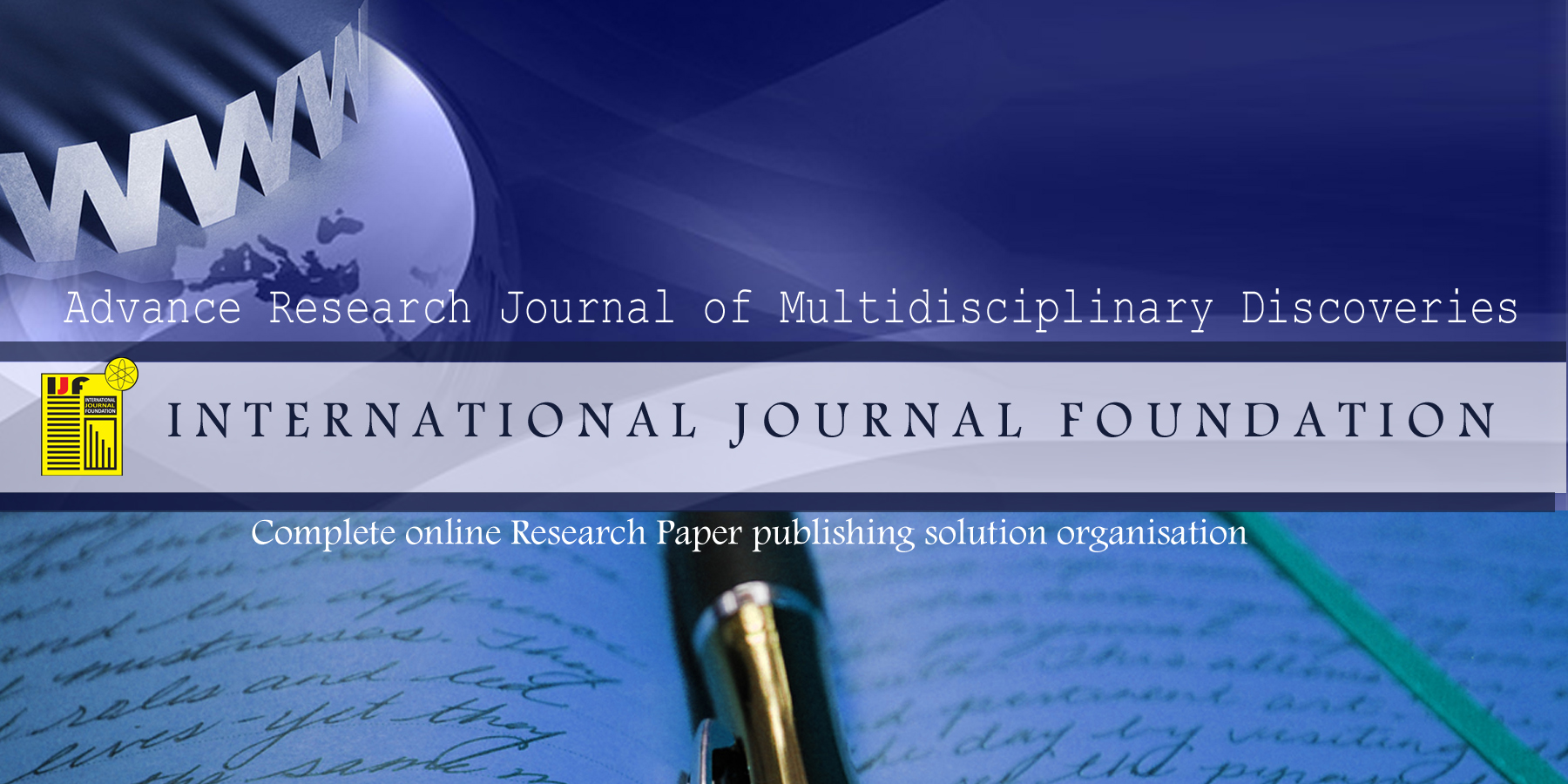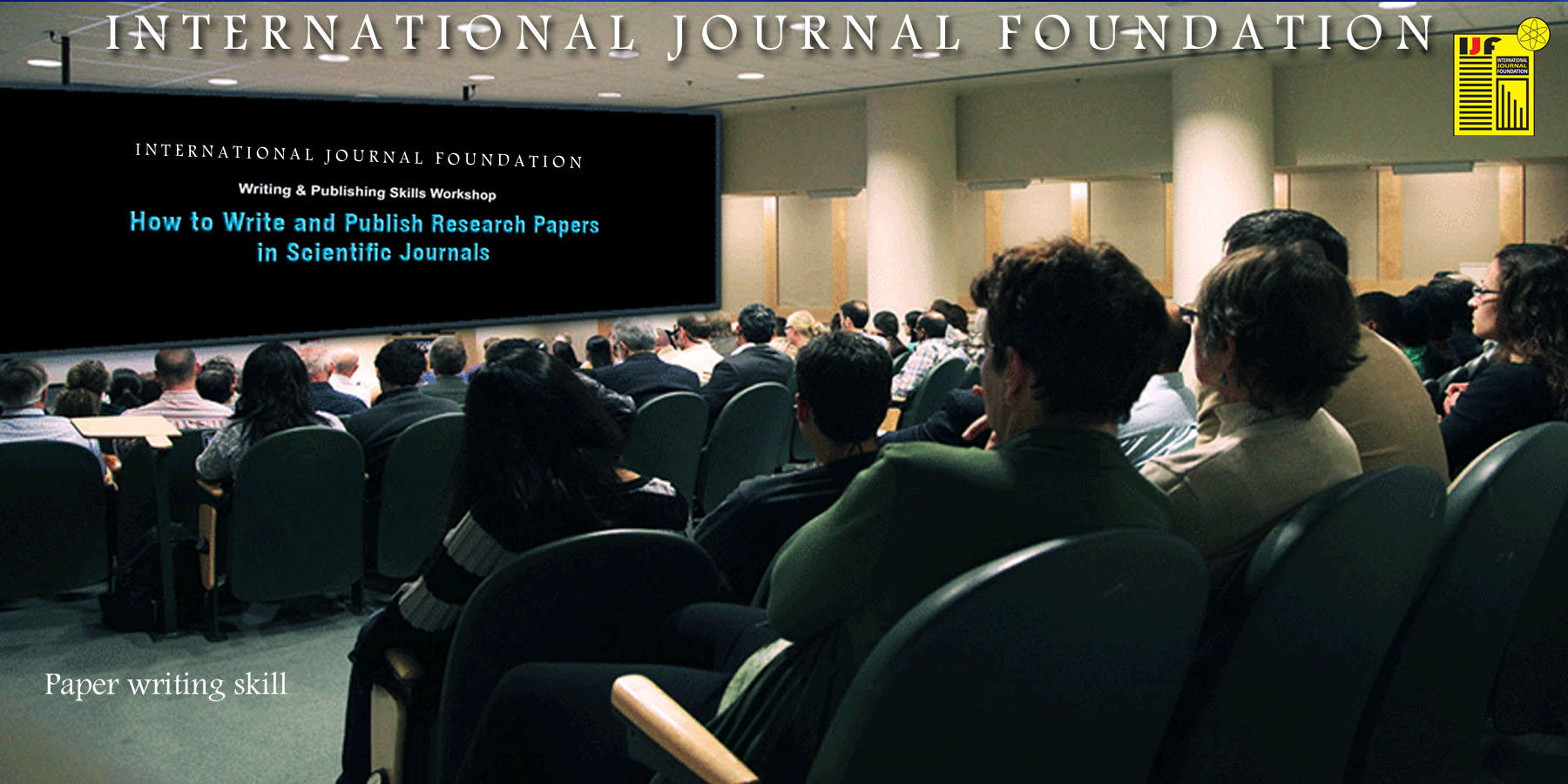2020
MARCH 2020/ Vol.47.0/ Issue-I
CATEGORY : Research Topic on Hydrology [ Original Research Article ]
| SL.No. | Detailed information of the published article |
| 1 | Manuscript Title : Evidence of groundwater contamination in a shallow aquifer. Author’s Name : Mustapha Olajiday Thomas Article Type : ORIGINAL RESEARCH ARTICLE Country from : SIERRA LEONE Date of Publication: 05-05-2020 Journal Name : Advance Research Journal of Multidisciplinary Discoveries [ ISSN : 2456-1045 ] Article Identification : Vol. 47.0/Issue-I/Chapter-I/Page – 01-05 [MARCH-2020 EDITION ] Article Code : HDG-V47-I1-C1-MAR-2020 Status : Officially published Publisher : International Journal Foundation Download PDF : Full article (Pdf) —————————————————————————————————————————– ABSTRACT: Groundwater use has intensified in recent years as uncertainties surrounding the capacity of public utility companies to provide sustainable drinking water increase. The upsurge has necessitated an unprecedented development of shallow groundwater sources by government, humanitarian agencies, and the private sector. There is a growing body of evidence which seem to suggest that the quality of groundwater used for drinking and other domestic use has been compromised. click here The objective of this study is to first ascertain whether the quality of groundwater in a shallow aquifer system has been compromised and thereafter determine the extent of the deterioration of water quality. A complementary objective is ascertaining the sources of contamination if any, and to recommend actions that needed to be taken to eliminate the threat. To achieve these objectives bacteriological tests were carried out on shallow groundwater sources to determine the content of faecal and non-faecal coliform bacteria. Bacteriological tests conducted on groundwaters in the area indicate that 46% of the sources investigated are of high risk, suggesting that they are highly contaminated and hence, unsafe for human consumption. The result also shows that only 27% of the drinking sources may be considered are safe for drinking, which calls into question the health status of users of the water. The principal source of contamination has been shown to be faecal coliform bacteria, which occurs in 73% of the sources investigated. To eliminate the threat of bacterial contamination, continuous chlorination is recommended on shallow dug wells considered to be of high risk until the threat is eliminated. KEYWORDS : Shallow groundwater; water quality; contamination; faecal coliform bacteria; drinking sources; risk assessment.

|
CATEGORY : Research Topic on Pharmaceutical Science [ Original Research Article ]
| SL.No. | Detailed information of the published article |
| 2 | Manuscript Title : Physio Chemical Standardization of Vasavennai –Siddha Medicine. Author’s Name : *Maanickha Chelvi K.S.1 , M. Natarajan2 , V. Gayathri Devi3 , Anitha John3 , A. Kanagarajan4 Article Type : ORIGINAL RESEARCH ARTICLE Country from : INDIA Date of Publication: 05-05-2020 Journal Name : Advance Research Journal of Multidisciplinary Discoveries [ ISSN : 2456-1045 ] Article Identification : Vol. 47.0/Issue-I/Chapter-II/Page – 05-11 [MARCH-2020 EDITION ] Article Code : PHS-V47-I1-C2-MAR-2020 Status : Officially published Publisher : International Journal Foundation Download: Full article (Pdf) —————————————————————————————————————————– ABSTRACT : Background: Siddha system of medicine having unique type of treatment called Varmam therapy. Its include internal medicine and external applications also. This therapy is widely used for musculoskeletal disorders such as fractures, dislocation, sprain, strain and degenerative disorders and for neurological deficit. In above said conditions, Post manipulation phase-certain periods of immobilization, the healing process usually lead to scar formation, which can cause stiffness of the joint. click here Objectives: The healing process, movement factors and further rehabilitation factors are contributing the progress of the any joint after the injury. When attempting to move after some period of inactivity can cause strain on the muscles and the tissues, making movement of joint difficult, feel stiff and results in discomfort and restriction of joint movement for a prolonged period. After Varmam manipulation in this condition, Vasavennai is one of the oil, which mentioned for lubrication and stiffness of the joint and allows free movements of joint. These not only help to improve range of motion but also help strengthen the muscles and tissues, increase flexibility, increase blood supply and reduce chances of injuries. The aim of the study is to standardize this preparation.Results: The Physiochemical parameters of this Vasavennai, Specific gravity, acid value, Iodine value, Peroxide value, saponification value and unsaponifiable matter are 0.971g/ml,6.46,nil, 9.735, 165.79 and 3.21% .KEYWORDS: Varmam Therapy, Rehabilitation, Stiffness, Vasavennai.
|
CATEGORY : Research Topic on Engineering [ Original Research Article ]
| SL.No. | Detailed information of the published article |
| 3 | Manuscript Title : Simulation of the Deep-Drawing Process: Influence of geometrical parameters on elastic springback of sheet metal. Author’s Name : *1Christian BOPDA FOKAM, 2Bienvenu KENMEUGNE, 3Théodore TCHOTANG Article Type : ORIGINAL RESEARCH ARTICLE Country from : CAMEROON Date of Publication: 25-05-2020 Journal Name : Advance Research Journal of Multidisciplinary Discoveries [ ISSN : 2456-1045 ] Article Identification : Vol. 47.0/Issue-I/Chapter-III/Page – 12-16 [MARCH-2020 EDITION ] Article Code : ENG-V47-I1-C3-MAR-2020 Status : Officially published Publisher : International Journal Foundation Download: Full article (Pdf) —————————————————————————————————————————– Abstract : The process of plastic deformation by deep-drawing sheet metal is used on a large scale in the industry. The main users are the automotive and aeronautical sectors. Improved competitiveness in this industrial sector can be achieved by reducing production costs by combining traditional know-how with the forecasting capabilities offered by numerical simulation, in particular using the finite element method. click here In this article we propose to study the influence of some parameters of the deep-drawing process on the elastic springback of thin sheet metal.. The process parameters studied in this study are: the dimension of the gap during bending between the sheet metal / punch interfaces and the corner radius of the deep-drawing tools. A model of the deep-drawing process was carried out in ABAQUS by considering a Johnson Cook type law of elastoplastic material behavior. Simulations show that an increase in the gap between the sheet metal/punch interfaces promotes elastic springback. A larger corner radius also produces greater elastic springback.KEYWORDS: Metal forming, Deep-drawing process, Finite Elements, elastic springback, Johnson Cook
|
CATEGORY : Research Topic on Medical Science [ Original Research Article ]
| SL.No. | Detailed information of the published article |
| 4 | Manuscript Title : The Hypercholesterolemia activity of common (Fagopyrum esculentum) buckwheat Author’s Name : * 1Raghavendra Rao M.V, 2Mahendra Kumar Verma, 3Abrar A Khan, 4Kumar Ponnusamy, 5Srinivasa Rao, 6Tiara Calvo Leon, 7Surekha Bhat, 8Pamphil Igman ,9Dilip Mathai Article Type : ORIGINAL RESEARCH ARTICLE Country from : INDIA Date of Publication: 25-05-2020 Journal Name : Advance Research Journal of Multidisciplinary Discoveries [ ISSN : 2456-1045 ] Article Identification : Vol. 47.0/Issue-I/Chapter-IV/Page – 17-24 [MARCH-2020 EDITION ] Article Code : MDS-V47-I1-C4-MAR-2020 Status : Officially published Publisher : International Journal Foundation Download: Full article (Pdf) —————————————————————————————————————————– Abstract : Cardiovascular diseases (CVDs) are the leading cause of morbidity and mortality across the globe, accounting for approximately one-third of all deaths. [1] High blood pressure, elevated total cholesterol and low density lipoprotein cholesterol (LDL-cholesterol), and low levels of high density lipoprotein cholesterol (HDL-cholesterol) concentrations are clinically considered as major CVD risk factors [2]. There are increasing epidemiological studies suggesting that diets rich in whole grains are linked to a lower risk of CVD and mortality. In recent years, there has been an increasing interest in the use buckwheat for its nutritional value and its effects on the cardiovascular system. Common buckwheat and Tartary buckwheat are among the top nine species with agriculture significance and are the most widely grown species in the world [3]. Buckwheat is a plant used for many purposes, such as consumed as a food and used in the treatment of diseases. It is a good source of many vitamins and minerals and has balanced nutritional value. Because of its nutrient content and many positive effects on human health, buckwheat has become a functional food, recently. Main effects of buckwheat on human health are its hypotensive, hypoglycemic, hypocholesterolemic, neuroprotective and antioxidant effects. Thus, it is considered an alternative food component in dietary treatment for chronic and metabolic diseases, such as diabetes, hypertension and celiac disease. Also, its rich nutrient content supports daily diet and provides a better eating profile. As a result, buckwheat is accepted as a functional food, suggested to improve human health and is used in the treatment of diseases. click here Besides the high starch content of energy source, it is rich in nutritionally valuable protein with a well-balanced amino acid profile, dietary fiber, lipids and minerals (manganese, copper, magnesium, iron, phosphorus), along with other health-promoting components such as phenolic compounds and sterols, which have attracted growing attention to buckwheat as a potential functional food [4]. The aim of this review is to explain some positive affects of buckwheat on human health [5] The body needs both HDL (high-density lipoprotein) and LDL cholesterol. LDL cholesterol is the basis for hormone production. Cholesterol undergoes a chemical conversion into the hormone pregnenolone followed by many other steps where it becomes testosterone and finally estradiol (estrogen). Without enough cholesterol, you would likely suffer multiple hormone deficiencies. Note: a more broad explanation of the importance of cholesterol. Cholesterol is a lipophilic molecule that contributes to many functions of the cell as well a precursor molecule. Cholesterol is an important component of the cell membrane with the role of maintaining the structural makeup and modulates the fluidity of the membrane. Is the precursor for the endogenous synthesis of vitamin D, steroid hormones (aldosterone, cortisol, and androgens in the adrenal cortex) and sex hormones (testosterone, estrogens, and progesterone in the gonads). [6] Cholesterol is also part of bile salts, needed for the facilitated absorption of fat-soluble vitamins (Vitamins A, D, E, and K) and fats from the diet. Cholesterol is transported through the blood with triglycerides inside lipoprotein particles (Chilomicrones, HDL, LDL, VLDL, IDL) [7]. HDL cholesterol is responsible for seeking out excess LDL cholesterol and taking it away from the arteries. If you have high LDL cholesterol levels, you are at an increased risk of developing atherosclerosis – hardening of the arteries due to clogging (plaque) from LDL cholesterol.
Lipoproteins core structure is made up of cholesterol esters and triglicerides, and the outer hydrophilic membrane of phospholipids, apoproteins, and free cholesterol; this allows the structure to move around the body and to be transported to cells that require them. LDL particles are thought to act as a major transporter of cholesterol, at least two-thirds of circulating cholesterol resides in LDL, to the peripheral tissues. Conversely, HDL molecules are thought to do the opposite, taking the excess cholesterol and return it into the liver for excretion. Clinically, high LDL and low HDL increase the risk for CVDs such as atherosclerosis vascular diseases [8], [9]. GH treatment reduces plasma LDL cholesterol by inducing LDL clearance. In humans, LDLR expression is a prerequisite for this effect, whereas it is not related to stimulation of bile acid synthesis [10]. High density lipoprotein removes tissue cholesterol and helps its transport. Cholesterol ester present in HDL cholesterol is transferred and incorporated in to VLDL and LDL cholesterol. Hence high HDL-cholesterol level reflects protective action on the animals because of its scavenging action. According to the NHLBI, your risk for heart disease and other health problems, such as diabetes, increases if you have an HDL cholesterol level of 40 milligrams per deciliter (mg/dL) or less for men and 50 mg/dL or less for women. The institute recommends that total daily cholesterol intake be less than 200 mg/dL, and that LDL cholesterol be less than 100 mg/dL. The association of high cholesterol and triglicerides in blood increases the risk for CVD. Observational studies on population have demonstrated that high levels of LDL cholesterol and apolipoprotein B (apoB) 100, are directly associated with risk for atherosclerotic cardiovascular events (ASCVE). Infiltration and the retention of apoB in the vascular wall initiates an inflammatory response and the promotion and development of atherosclerosis. An unresolved inflammation of the artery wall results of vulnerable [11], [12]. An unresolved of the wall vessel inflammation results in necrotic cell death leading to an increased smooth muscle cell death, decreased extracellular matrix production, and collagen degradation by the protease of the macrophages. The rupture of the weak thinning fibrous cap will promote the formation of thrombus and eventually resulting in the clinical ischemic ASCVE [13]. Atherosclerotic plaque can break free from arterial walls or rupture and cause blood clots that can impede blood flow to the brain or heart. The result from this would be a stroke or heart attack. High fat content in diet increased blood cholesterol in rabbits. Along with high fat diet if some spices are also ingested, they are likely to influence blood cholesterol levels. This hike in blood cholesterol level is important in the development of atherosclerosis. Cholesterol is present not only in the free form in the blood but remarkable amount of cholesterol is transported as a component of different lipoproteins. KEYWORDS: Cardiovascular diseases, lipoprotein cholesterol, buckwheat, lipoprotein particles, Atherosclerotic plaque |
CATEGORY : Research Topic on Medical Science [ Original Research Article ]
| SL.No. | Detailed information of the published article |
| 3 | Manuscript Title : Survey of Schistosoma haematobium among Basic School Children in Urban and Rural Communities in Khartoum North, Khartoum State, Sudan. Author’s Name : * Nadia A Elsammani1, Abdelghaffar Ali Adam2,Adam Abdalla Mater3 Article Type : ORIGINAL RESEARCH ARTICLE Country from : SUDAN Date of Publication: 10-02-2020 Journal Name : Advance Research Journal of Multidisciplinary Discoveries [ ISSN : 2456-1045 ] Article Identification : Vol. 45.0/Issue-I/Chapter-III/Page – 10-16 [JANUARY-2020 EDITION ] Article Code : MDS-V45-I1-C3-JAN-2020 Status : Officially published Publisher : International Journal Foundation Download: Full article (Pdf) —————————————————————————————————————————– Abstract : A cross-sectional study was conducted to determine the prevalence of S. haematobium among school children in selected basic schools in a rural and an urban area in Khartoum North, Khartoum State, Sudan. A structured questionnaire was administered to 600 children to collect information used to determine the factors associated with Schistosomiasis. click here Urine specimens (600 samples) were examined using the standard sedimentation technique to determine the prevalence of S.haematobium. Overall, prevalence of S.haematobium in both communities was of 15.7% a rural area had a higher prevalence 16.0% compared to an urban community 15.3%.The prevalence rates were significant in both communities, with gender in both communities, males was recorded higher infection rate than females, 90(23.5%) and 4(1.8%), respectively, while age group 13-15 year age group recorded the highest prevalence18(22.2%) and 21(17.1%) in the urban area and the rural area, respectively. When compared to other age groups, these differences were significantly different (p < 0.05) in both communities. It was concluded that Schistosomiasis remains a serious public health concern in Sudan. Therefore, application appropriate integrated control program will significantly reduce the disease transmission.KEYWORDS : Schistosoma haematobium, Prevalence, Rural, Urban. 
|
N.B: Our publication process is going on. More paper will be added very shortly in this current issue…
(i) To Publish your paper in our upcoming issue send your article directly at article.ijf@gmail.com
![]()
![]()
![]()
![]()
![]()
















